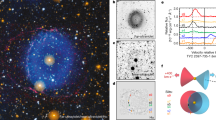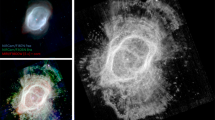Abstract
The enigmatic object η Carinae is believed to represent an important, but short-lived, unstable phase in the life of the most massive stars, occurring shortly before they explode as supernovae or collapse directly to black holes. The putative binary1,2 system believed to constitute η Carinae survived an outburst in the previous century that lasted 20 years; and which created a nebula with pronounced bipolar lobes that together contain about 2.5 solar masses of material. The nebula also exhibits an equatorial ‘waist’ containing about 0.5 solar masses3. The physical mechanisms responsible for the outburst and the bipolar geometry are not understood. Here we report infrared observations (spectroscopy and imaging) that reveal the presence of about 15 solar masses of material, located in an equatorial torus. The massive torus may have been created through highly non-conservative mass transfer, which removed the entire envelope of one of the stars, leaving an unstable core that erupted in the nineteenth century. The collision of the erupted material with the pre-existing torus provides a natural explanation for the bipolar shape of the nebula.
This is a preview of subscription content, access via your institution
Access options
Subscribe to this journal
Receive 51 print issues and online access
$199.00 per year
only $3.90 per issue
Buy this article
- Purchase on Springer Link
- Instant access to full article PDF
Prices may be subject to local taxes which are calculated during checkout


Similar content being viewed by others
References
Damineli,A. The 5.52 year cycle of Eta Carinae. Astrophys. J. 460, L49–L52 (1996).
Davidson,K. Is Eta Carinae a long-period binary? New Astron. 2, 387–396 (1997).
Davidson,K. & Humphreys,R. M. Eta Carinae and its environment. Annu. Rev. Astron. Astrophys. 35, 1–32 (1997).
Nota,A. & Lamers,H. (eds) Luminous Blue Variables: Massive Stars in Transition (ASP Conf. Ser. 120, Astronomical Society of the Pacific, San Francisco, 1997).
Morse,J. A., Humphreys,R. M. & Damineli,A. (eds) Eta Carinae at the Millennium (ASP Conf. Ser. 179, Astronomical Society of the Pacific, in the press).
Frank,A., Balick,B. & Davidson,K. The Homunculus of Eta Carinae: an interacting stellar winds paradigm. Astrophys. J. 441, L77–L80 (1995).
Dwarkadas,V. V. & Balick,B. On the formation of the Homunculus Nebula around η Carinae. Astron. J. 116, 829–839 (1998).
Langer,N., García-Segura,G. & Mac Low,M.-M. Giant outbursts of luminous blue variables and the formation of the Homunculus Nebula around η Carinae. Astrophys. J. 520, L49–L53 (1999).
Aitken,D. K., Smith,C. H., Moore,T. J. T. & Roche,F. Mid-infrared studies of η Carinae—II. Polarimetric imaging at 12.5 µm and the magnetic field structure. Mon. Not. R. Astron. Soc. 273, 359–366 (1995).
Duschl,W. J., Hofmann,K.-H., Rigaut,F. & Weigelt,G. Morphology and kinematics of Eta Carinae. Rev. Mex. Astron. Astrof. 2, 17–22 (1995).
Falcke,H., Davidson,K., Hofmann,K.-H. & Weigelt,G. Speckle-masking imaging polarimetry of η Carinae: evidence for an equatorial disk. Astron. Astrophys. 306, L17–L20 (1996).
Rigaut,F. & Gehring,G. The inner core of η Carinae in the near infrared. Rev. Mex. Astron. Astrofis. 2, 27–35 (1995).
Zethson,T. et al. Strange velocities in the equatorial ejecta of Eta Carinae. Astron. Astrophys. 344, 211–220 (1999).
Cox,P. et al. Millimeter emission of Eta Carinae and its surroundings. Astron. Astrophys. 297, 168–174 (1995).
Smith,N., Gehrz,R. D. & Krautter,J. The infrared morphology of η Carinae. Astron. J. 116, 1332–1345 (1998).
Smith,N., Guzik,J. A., Lamers,H. J. G. L. M., Cassinelli,J. P. & Humphreys,R. M. in Variable and Non-spherical Stellar Winds in Luminous Hot Stars (ed. Wolf, B. et al.) 249–250 (IAU Symp. 169, Springer, Heidelberg, 1999).
Smith,C. H. et al. Mid-infrared studies of η Carinae—I. Subarcsecond imaging at 12.5 and 17 µm. Mon. Not. R. Astron. Soc. 273, 354–358 (1995).
Kessler,M. et al. The Infrared Space Observatory (ISO) mission. Astron. Astrophys. 315, L27–L31 (1996).
Davidson,K., Dufour,R. J., Walborn,N. R. & Gull,T. R. Ultraviolet and visual wavelength spectroscopy of the gas around Eta Carinae. Astrophys. J. 305, 867–879 (1986).
Viotti,R., Rossi,L., Cassatela,A., Altamore,A. & Baratta,G. B. The ultraviolet spectrum of Eta Carinae. Astrophys. J. Suppl. 71, 983–1009 (1989).
de Graauw,Th. et al. Observing with the ISO short-wavelength spectrometer. Astron. Astrophys. 315, L49–L54 (1996).
Clegg,P. E. et al. The ISO long-wavelength spectrometer. Astron. Astrophys. 315, L38–L42 (1996).
Harvey,P. M., Hoffmann,W. F. & Campbell,M. F. High angular resolution observations of η Carinae from 35–175 microns. Astron. Astrophys. 70, 165–168 (1978).
Humphreys,R. M. & Davidson,K. The luminous blue variables: astrophysical geysers. Publ. Astron. Soc. Pacif. 106, 1025–1051 (1994).
Morse,J. et al. Hubble Space Telescope wide field planetary camera 2 observations of Eta Carinae. Astron. J. 116, 2443–2461 (1998).
Acknowledgements
We appreciate the use of the composite HST images constructed by J. Morse. We also thank E. Lellouch for assistance with calibrations pertaining to Uranus, I. Yamamura for discussions, and S. F. Moseley for access to the recent unpublished KAO photometry of η Car. This work was supported in part by a Pioneer grant to L.B.F.M.W. and a NWO Spinoza grant to E.P.J. van den Heuvel. This work is partly based on observations with ISO, an ESA project with instruments funded by ESA member states and with the participation of ISAS and NASA. It also involves observations obtained at the European Southern Observatory, La Silla, Chile.
Author information
Authors and Affiliations
Corresponding author
Rights and permissions
About this article
Cite this article
Morris, P., Waters, L., Barlow, M. et al. Discovery of a massive equatorial torus in the η Carinae stellar system. Nature 402, 502–504 (1999). https://doi.org/10.1038/990048
Received:
Accepted:
Issue Date:
DOI: https://doi.org/10.1038/990048
This article is cited by
-
A massive cool dust torus around η Carinae?
Nature (2000)
Comments
By submitting a comment you agree to abide by our Terms and Community Guidelines. If you find something abusive or that does not comply with our terms or guidelines please flag it as inappropriate.



